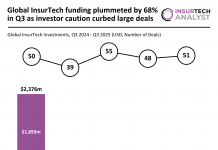Customers expect more from their insurers than ever before. So how can companies make sure to get it right?
If you’re looking for a key moment that set the tone for the last decade, then you can’t go wrong with January 9, 2007. That was when Steve Jobs took to the stage at the Moscone Center in San Francisco and announced to the world that Apple was launching a device that would be a combined MP3 player and mobile phone with internet connection: the iPhone.
The announcement was the key to the paradigm shift that fundamentally changed how people buy stuff, date and find taxis, just to mention a few things. However, it has also meant a revolution in what customer expects from businesses.
What this means for the insurance industry was one of the topics up for discussion at the recent Virtual InvesTech Forum 2020.
The conversation kicked off with Matthew Jones, principal at Anthemis, the venture capital firm, asking how customer expectations have changed in the last decade.
“Fundamentally, we’ve probably got lazier and lazier [while[ our expectations have got higher and higher,” answered Sam White, CEO at Stella, the female-focused Australian InsurTech. “And the businesses that are serving is trying to keep pace with that where I’m almost expecting them to read my mind and know exactly what I want at any time and for my interaction and my input to be absolutely minimal.”
However, even though many businesses have managed to digitalise their customer experiences, White believed the insurance industry still have some ways to go. “We’re pretty far behind the curve in terms of customer expectations and customer-centricity in terms of how we deliver products to people and how we engage with them,” she said.
This, Jones said, was even more apparent when looking at other segments of the financial industry that have enjoyed far more digitalisation. “I think a lot of customers have seen what’s possible in other parts of financial services, and their expectations have risen as a result in insurance and the insurers have been playing catch up to make sure that expectations are met by customer expectations,” he said.
Aydin Betez, global head of digital and innovation at Willis Re, the reinsurer, agreed, saying, “Customers are no longer [forgiving] clunky experiences.”
He argued that it was basically a mortal sin for a business to be heavily reliant on emails, Word, Excel, an abundance of manual steps, if their services only work in one browser or if they are dependent on a smattering of other burdensome legacy systems. “[Now it is] really evident when people aren’t taking this seriously,” Betez said.
Moreover, customer experiences could have become even more important these days due to the internet having brought an added sense of transparency for the sector. “Everyone knows each other’s price now,” said Jon Cooper, founder and CEO of Life.io, the customer engagement and experience company.
That, he argued, meant that everyone can match each others prices and services, making great customer experiences even more essential. “It’s easy to copy product, but experience is harder to recreate,” Cooper said. “[If] you look at the whole FinTech movement, the unicorns, [they’re] not offering something new. They’re offering something that everyone’s been doing for a while, but they’re delivering it in a way that’s much more interesting, much more exciting, and I feel like the pace of change around customer experience and customer expectation is going to continue to accelerate.”
But things are changing. Simon Clayden, COO of technology at AXA UK, the insurer, pointed at the last six months and how insurers have been forced to go digital to a further extent because of Covid-19. He argued that this will only have to speed up in the months and years to come.
Particularly, he suggested that firms must ensure a frictionless experiences that complement the human interactions with those of artificial intelligence-based ones. He also predicted that there may be a bigger move in the years ahead for on-demand insurance. “We’ll gradually see a move towards usage-based insurance and insurance where hiking is orchestration for complimentary services that they can offer to their customers as well as their base product.
Cloyden added that as insurers look to bolster their customer experiences through technology, they must make sure to talk with the customers and find out what they actually want. “[Put] yourself in their shoes, empathise, so you’re creating scenarios and experience [and] kind of map out where there were frustration, points hurdles [and] barriers to overcome,” he said.
Betez argued that, as businesses look to boost their customer experiences, they shouldn’t forget how it will affect the employees on the other side. “If you can’t attract, recruit and retain talent, you will never be able to deliver that customer experience that you need to achieve,” he said.
Copyright © 2020 FinTech Global










